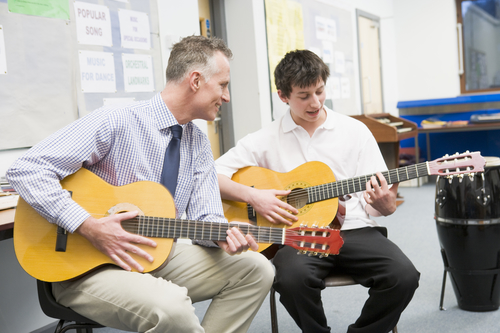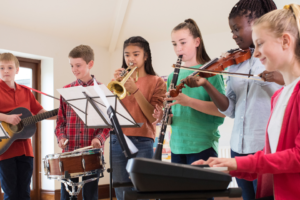
The Flipped Classroom and Guitar Instruction
 Guitar instruction has moved at the pace of technology. Aspiring players can learn independently using online tools without necessarily relying on an instructor. While this broadens opportunities for students to learn on their terms, it carries the inherent risk of them developing poor habits without a talented instructor to guide them. Here is where guitar teachers can intervene. A productive way for guitar teachers to bridge technology and expert guidance is through the model of a flipped classroom.
Guitar instruction has moved at the pace of technology. Aspiring players can learn independently using online tools without necessarily relying on an instructor. While this broadens opportunities for students to learn on their terms, it carries the inherent risk of them developing poor habits without a talented instructor to guide them. Here is where guitar teachers can intervene. A productive way for guitar teachers to bridge technology and expert guidance is through the model of a flipped classroom.
The flipped classroom has gained traction in many schools. The basic concept is simple. Teachers give students the responsibility of learning skills or content outside of class. Students engage the material by reading, researching, and viewing video tutorials. Class time then becomes a venue for applying the newfound skills or content knowledge in exercises conducted under the eye of the teacher. In this model, the teacher becomes a facilitator as much as an instructor. Students take ownership of their learning and class time is used efficiently.
The flipped classroom model has great utility for music instruction, in particular for guitar. A massive archive of guitar instruction videos exists online, giving guitar students unprecedented access to techniques suited for novice to advanced players. By tapping this ever-growing archive, a guitar teacher can assign tutorials a student can use outside of class for the purpose of learning a specific technique or even an entire piece. Class time can become an opportunity for refinement and practice with other musicians. Practicing with others might be the best way to foster growth on an instrument. Allowing ample class time for this is preferable to spending this time working on drills or skill acquisition.
The teacher still has an important role in this model. Some websites allow anyone to upload anything, resulting in a staggering array of quality in the online archives. This applies to guitar instructional videos, even those that appear professionally made. Some are wonderful. Many are not. One of the teacher’s functions will be to sift through videos and select relevant, high-quality tutorials. The teacher might select videos from a commercial series that can be downloaded or purchased. Instead, the teacher might select others that available for free. An entire series might not be appropriate. The teacher can knowingly select the best videos à la carte to provide the most rounded or most individually tailored instructional experience.
The teacher’s role doesn’t end at selecting a program. If the student has questions while working through a preselected video series, the teacher can field these during class time. The teacher and student can work together in person to clarify anything that was confusion during the video. If possible, this clarification can happen virtually via chat while the student is practicing with the video at home. The student might be able to find additional support online should the teacher not be available in real time. In anticipation of this, the teacher might wish to steer the student towards appropriate live resources to help prevent against the student getting bad advice.
This model’s greatest advantage is freeing up class time for guided practice. A student might learn a technique outside of class, along with a song that uses the technique. In class, the student and teacher can play the song together and tighten the use of the technique. Perhaps a group of students can play together, each focusing on the techniques they’ve been individually mastering. As the expert, the teacher can pick selections that incorporate what each student has been learning.
The flipped classroom model makes use of technology while still relying on a teacher’s expertise. It also maximizes the value of class time. As students understand how to use online resources wisely, they can gain a transitional skill that will help them throughout their playing career. In this way, using the flipped classroom model can lead to lifelong players who continually challenge themselves to improve. It will work best with the most motivated players, but it will empower these players to become active learners.
Written by Jeff Hartman



